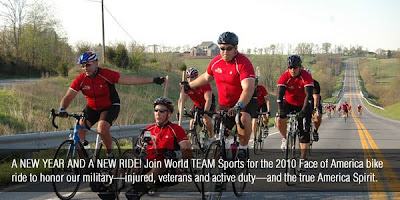“I know if my husband or any of my friends were to have this happen to them, I’d want them to know that people care about them. If it can help someone, it’s definitely worth it to me.”
- Leslie Scott, Air Force spouse and Soldiers' Angel
Leslie carried out her
first supply drive for Soldiers' Angels Germany while stationed in the UK and before she had ever visited Landstuhl hospital. After that visit, she was more determined than before to keep supporting patients medevaced to Germany from Iraq and Afghanistan.
After a PCS to Cannon Air Force Base in New Mexico with her husband Nathan, Leslie started planning the next drive. We emailed about the items needed, and Leslie put together informational flyers and a poster for her dropoff point. She started to get the word out by contacting her local radio station, which ran spots. The local newspaper wrote up a blurb.
The idea was to set up a table outside Wal-Mart and collect a few items.
 Kids with bags of donations larger than themselves at the Wal-Mart drive, which generated 3 large boxes of donations in kind and $800 in cash.
Kids with bags of donations larger than themselves at the Wal-Mart drive, which generated 3 large boxes of donations in kind and $800 in cash.Phase 1, as she now calls it, was a dropoff point at Wal-Mart which generated $800 and about 3 large boxes of donations. Fewer donations in kind than she had expected, but much more cash.
Then she spoke with her pastor, Alan McAlister of Central Baptist Church. He loved the idea and Phase 2 was born - the supply drive got a spot during the "Minute for Missions" portion of the Sunday service. The AV person at Central Baptist put together video clips about Soldiers' Angels and Landstuhl.
 The supply drive table with dropoff box at Central Baptist Church.
The supply drive table with dropoff box at Central Baptist Church.After the service people surrounded Leslie's table in the church lobby to pick up flyers and ask questions. Like the older man who asked, "Can't I just give you money? I don't care for shopping." Of course Leslie said that would be fine. Only after she got home did Leslie realize that what she "thought was a 10 & 20 was actually two $50 bills".
The first wave of donations from the congregation generated 5 large boxes of donations and $200 in cash. Now Central Baptist would like to have Leslie set up the table quarterly...
 Impact Confections stopped by with a little donation of gourmet lollipops via the Airman and Family Readiness Center of Cannon AFB. YIKES! Seriously, this is a wonderful donation that Leslie has spread all over Germany, Iraq, and Afghanistan! As Leslie's husband said, the guys downrange will devour any and all candy :-)
Impact Confections stopped by with a little donation of gourmet lollipops via the Airman and Family Readiness Center of Cannon AFB. YIKES! Seriously, this is a wonderful donation that Leslie has spread all over Germany, Iraq, and Afghanistan! As Leslie's husband said, the guys downrange will devour any and all candy :-)Then a friend suggested she write to local veterans groups, which became Phase 3. VFW Post 3015, VFW Post 3280, and the Fraternal Order of Eagles, all of Clovis, NM, responded with generous donations totalling $2,750. The funds were used to make bulk purchases of some of our most-needed items: Sweatpants and hoodies, lip balm, and travel sized aerosol shaving cream.
 Leslie with the Littlest Patriots: A preschool class at Cannonn AFB, who organized their own supply drive at Wal-Mart and made blankets for wounded service members.
Leslie with the Littlest Patriots: A preschool class at Cannonn AFB, who organized their own supply drive at Wal-Mart and made blankets for wounded service members.Word kept spreading... a preschool class at Cannon AFB did their own supply drive at Wal-Mart and at the school, becoming Phase 4. Three large boxes of supplies and two handmade blankets for the Landstuhl patients were donated.
Phase 5: During the Wal-Mart drive someone from the Airman & Family Readiness Center of Cannon AFB stopped by and asked, "Why didn't you come see us?". Being so new in town, Leslie hadn't felt right about approaching them. But they were eager to participate and set up a drop box in their office for November and December. Now they're talking about continuing the project throughout the year...
 Even the dog wants to help! One of Leslie's 8-ft packing tables stacked with donations headed to Soldiers' Angels Germany for the patients at Landstuhl Regional Medical Center.
Even the dog wants to help! One of Leslie's 8-ft packing tables stacked with donations headed to Soldiers' Angels Germany for the patients at Landstuhl Regional Medical Center.All told, Leslie has sent over 2000 lbs of clothing, personal care items, phone cards, and other goodies to us for the patients and staff at Landstuhl.
So far, that is. As Leslie says, this is the supply drive that just keeps going... so stay tuned!
THANK YOU Leslie for your leadership, and to the entire community in and around Cannon AFB for your generosity and your patriotism.
By the way, it will come as no surprise to learn that Leslie's an entrepeneur in more ways than one. Check out her online business,
Quilts by Leslie.

















































